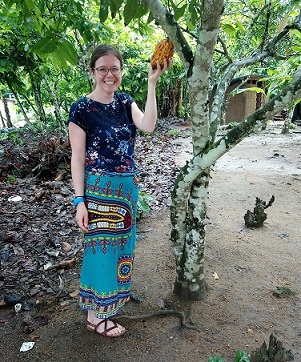Menu
Current Research
At the current time I am working on three different research projects. This page tells you more about each project, and my contribution.
Mars Cocoa and Climate
Project Background
Recent research suggests that cocoa production will decline over West Africa under future climate change. A large proportion of the world's cocoa comes from West Africa, and it is incredibly important to the local economy; it is estimated that around 7% of Ghana's GDP is dependent upon cocoa. Therefore a decline in cocoa production under climate change has the potential for severe consequences.
However, current research is based upon defining a "climatic envelope" in which cocoa grows under current climate. This "climatic envelope" is then used to determine a region's suitably for cocoa production under future climate change. This approach has a number of caveats, most notably, it assumes that cocoa cannot grow in any climate that it is not currently observed to grow in.
Therefore, the question of changing climatic suitability for cocoa cultivation has motivated MARS-Wrigley to commission a research project on the effect of long term climate variability and change on cocoa in Brazil, Peru, Ecuador, Indonesia and West Africa. The three aims of the project are:
- Investigation of the sensitivity of cocoa yield to changes in CO2, temperature and rainfall
- Assessment of change in temperature and precipitation variability in the study regions over the next 20-100 years using high- and standard-resolution global climate models
- Prediction of the impact of climate change on cocoa production in the study regions over the next 20-100 years
The first paper from this project is on "Cocoa plant productivity in West Africa under climate change". In this study a data assimilation technique is used to parameterise a process-based land-surface model to represent cocoa growth. The parameterisation is based on laboratory observations of cocoa, grown under both ambient and elevated CO2. Present day and end of 21st century cocoa cultivation scenarios are produced by driving the parameterised land-surface model with output from a high-resolution climate model (UPSCALE). The main results are:
- Under future climate change, temperature is projected to increase significantly and precipitation is projected to increase slightly, although not in all parts of the region of interest.
- The physiological effect of higher atmospheric CO2 concentration ameliorates the impacts of high temperature and variation in precipitation thereby reducing some of the negative impacts of climate change and maintaining net primary productivity in West Africa, for the whole of the 21st Century, even under a high emissions scenario.
My WorkI am working on the second of three aims stated above, looking at changes in temperature and precipitation variability over the regions of interest. In order to achieve this I am using climate model simulations produced as part of the CMIP5 and CMIP6 processes, and high resolution simulations produced as part of the UPSCALE project. I am also looking at changes in climatic extremes, using the CLIMDEX indices to quantify extremes. Right: Visiting a village cocoa plantation on a recent trip to Ghana. |
 |
HyCristal
Project Background
HyCristal (Integrating Hydro-Climate Science into Policy Decisions for Climate-Resilient Infrastructure and Livelihoods in East Africa) is the East Africa part of Future Climate for Africa (FCFA).
HyCristal aims to develop understanding of climate variability and change over East Africa, a region where water availability is fundamental for development, yet water is often in limited supply. Climate change is likely to exacerabate water stress. HyCristal also aims to improve understanding of the impacts of climate change and variability, and work with decision makers to support decision making in the face of climate change. More details on the HyCristal project can be found here.
A summary of the advances in scientific understanding of East African climate change gained through this project can be found here.
My Work
My work on the HyCristal project has focused around looking at changing seasonality under future climate change. Much of the work has followed on from the final chapter of my PhD Thesis, which looked at projections of onset and cessation of the wet season across Africa under climate change.
Additionally, I have done some work looking at the recent changes in the long rains (which occur in March-May). This work found that the observed decline in the long rains from the 1980s to early 2000s was linked to a shorter season, with later onset and earlier cessation. These changes in onset and cessation were linked to changes in the Arabian Heat Low and SST gradients in the Indian Ocean. The paper is available here.
SWIFT
Project Background

GCRF Africa SWIFT (Science for Weather Information and Forecasting Techniques) is a major programme of research and capability building aiming to improve African weather forecasting skill. The project is divided into 3 strands; user engagement and forecast evaluation, physical science research, and knowledge exchange, training and documentation. The project has a strong focus on capacity building and capability strengthening, and working with African researchers and operational meteorologists is at the heart of the project.
My Work
I am involved with work package 6 on "Sub-seasonal to Seasonal Forecasting". The majority of my work thus far has been around preparing materials for the Summer School that was held in Kumasi, Ghana in July-August 2019. You can read more about the summer school here. The summer school practicals were on defining and forecasting the onset of the wet season over Ghana, and we hope to publish the results from this soon. I also lead the fortnightly SWIFT Weather Chat - a platform for researchers and forecasters to discuss recent weather events.